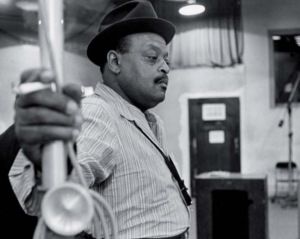Business & Education
Here lies an all-time great of jazz
This article is more than 9 years old.
One of the most beloved jazz saxophonists of the swing era, Ben Webster, enjoyed playing in Denmark so much he decided to stay

Honorary Dane and saxophonist supreme Ben Webster is buried in Copenhagen’s Assistens Cemetery (photo: comunicom.es – Flickr)
Assistens Kirkegård in the Nørrebro neighbourhood of Copenhagen is the Pere Lachaise of Denmark, a tree-lined cemetery in the heart of the inner city where oddballs amble dazed and confused in their search for the graves of the famous, and where topless sunbathers relax just yards from the final resting places of Hans Christian Andersen and philosopher Søren Kierkegaard.
There are many other figures here too, perhaps not so well-known internationally, but who all contributed in some way to this country’s history. One of them is Ben Webster, leading jazz saxophonist of the swing era, and an American who became an honorary Dane in the 1960s.
Born in Kansas City, USA on 27 March 1909, Ben Webster took the tenor sax as his instrument in 1929, after a smattering of violin lessons as a child were followed by a brief flirtation with the piano.
Dancing with the Duke
He learned to play the blues from his neighbour, and for a time he worked as the musical accompaniment to silent films in Texas. His first stint playing sax professionally was in the Young Family Band, which at that time still included Lester Young. Periods with Gene McCoy, Jap Allen, Blanche Calloway and, last but not least, Bennie Moten, soon followed.
During the 1930s, he worked with Cab Calloway and Willie Bryant, among others. In 1940, he became the first major saxophonist to join Duke Ellington’s orchestra. He stayed with the band for three years, contributing to many famous recordings, including ‘All Too Soon’ and ‘Cottontail’. Legend has it he left the band after a fall-out with the Duke culminated in Webster cutting one of Ellington’s best suits to ribbons.
Along with short periods of work with Raymond Scott, John Kirby and Sid Catlett, Webster led his own groups and toured with Jazz at the Philharmonic during several seasons in the 1950s. But with his sound starting to go out of fashion by that time, his interests moved to foreign shores.
Living jazz in CPH
A guest appearance on Danmarks Radio in January 1964 together with Jazzhus Montmartre’s house band – consisting of pianist Kenny Drew, drummer Alex Riel and the recently deceased Niels Henning Ørsted Pedersen on bass – made for a fortuitous collaboration, so much so in fact that later that year he chose to move to Copenhagen. Here, he settled down in Store Regnegade in the heart of the Inner City right above the JazzHouse, playing where he pleased and bringing great pleasure to Danish jazz musicians and enthusiasts, as so many other faces travelled from all over Europe to play with him.
His regular recordings from this period tended to come out of Sweden, but a live recording of him playing at Copenhagen’s JazzHouse from 1965, accompanied by Kenny Drew on the piano, has long been a jazz classic. The fact that it has recently been remastered by Germany’s da music label just goes to show the timelessness of his music.
Webster’s move to Copenhagen was no retirement, and he continued playing along with the greats right up until his death, although old age required him to perform sitting down. He died whilst on tour in Amsterdam of a brain haemorrhage in September 1973.
While he may have made many happy with his promotion of Danish jazz, off the stage he offended many with his sharp tongue: Webster was an outspoken character who was never afraid of criticising loudly those he believed deserved it. All unpleasantness melted, however, when he picked up his sax and played a ballad with unbelievable warmth and sentiment, a sound so tender that he could be forgiven for almost anything.










































